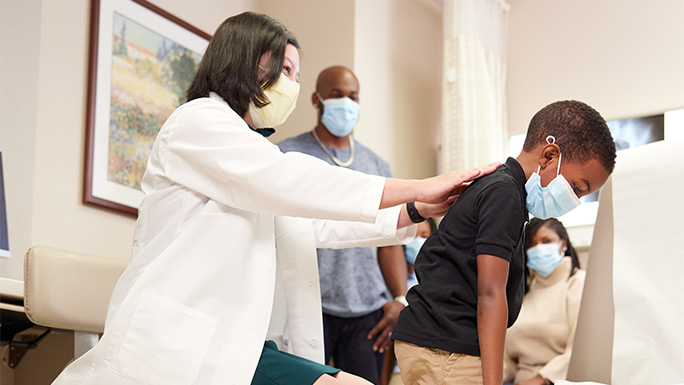Pediatric Spine Care

Finding out that your child has a spine issue or deformity can be frightening, so finding an expert team with the experience and skill you can trust is crucial. The University of Chicago Medicine Comer Children’s Hospital’s comprehensive pediatric spine team can guide you and your family as you make healthcare decisions that can positively impact your child’s overall quality of life. We deliver personalized treatments that are designed to not only address pain, swelling and other symptoms of spine distress, but will also enhance your child’s mobility, range of motion and more.
Pediatric Spine Conditions We Treat
Kyphosis
Kyphosis is an abnormal forward curve in the upper spine. Children with kyphosis have a rounded or "hunchback" appearance. While some children are born with kyphosis, most cases of kyphosis develop during adolescence. Some degree of front-to-back curve of the spine is normal and healthy, but if your child’s spine curves forward 50 degrees or more, our pediatric spine team can help.
Though most cases of adolescent kyphosis are mild and do not require spine treatment, teens with kyphosis must be closely monitored to observe how your child’s condition continues to progress. If the forward curve becomes more severe, it can lead to pain and deformities that can compress the lungs and impact their breathing. Kyphosis can be treated with specialized exercises, physical therapy and bracing, or some may require surgery.
Scoliosis
When a child has scoliosis, their spine is malformed, taking on a C or S shape. A common symptom of scoliosis is a difference in shoulder and/or hip height and may become noticeable during the adolescent growth spurt. Our expert orthopaedic physicians will know what treatment(s) will be best for your child.
Children with mild scoliosis often do not need treatment beyond regular observation to monitor how your child’s spine is progressing as he/she grows in order to prevent any additional curvature.
For children with more severe scoliosis, treatment can include:
- Physician therapy
- Bracing
- Surgery (spinal fusion)
Our pediatric spine team will work with you and your child to find a plan that will meet your child’s healthcare goals.
Spondylolysis and Spondylolisthesis
Spondylolysis is a lower back stress fracture that is usually caused by sports injuries that require repetitive back motions or overuse. Treating this fracture is important to prevent more serious spinal damage later, as untreated spondylolysis fractures can lead to spondylolisthesis.
Spondylolisthesis occurs when a stress fracture worsens over time, and allows the vertebra to move abnormally, causing alignment issues and leading to pain and a higher risk for more severe damage.
For kids dealing with spondylolysis, we recommend using RICE (rest, ice, compressions and elevation) and pain/inflammation medication as a first step. If your child’s spondylolysis is more intense, physical therapy can help gently treat the stress fracture.
If the condition has moved beyond spondylolysis and into spondlyolisthesis, treatment can start with non-surgical options, such as physical therapy, but if the injury has continued to worsen, we offer surgery that will strengthen and stabilize your child’s spine.
